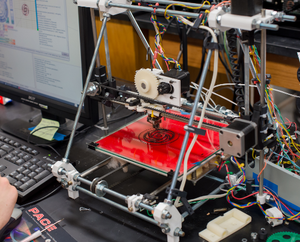
Although additive layer manufacturing is well established for rapid prototyping the low throughput and historic costs have prevented mass-scale adoption. The recent development of the RepRap, an open source self-replicating rapid prototyper, has made low-cost 3-D printers readily available to the public at reasonable prices (<$1,000). The RepRap (Prusa Mendell variant) currently prints 3-D objects in a 200x200x140 square millimeters build envelope from acrylonitrile butadiene styrene (ABS) and polylactic acid (PLA). ABS and PLA are both thermoplastics that can be injection-molded, each with their own benefits, as ABS is rigid and durable, while PLA is plant-based and can be recycled and composted. The melting temperature of ABS and PLA enable use in low-cost 3-D printers, as these temperature are low enough to use in melt extrusion in the home, while high enough for prints to retain their shape at average use temperatures. Using 3-D printers to manufacture provides the ability to both change the fill composition by printing voids and fabricate shapes that are impossible to make using tradition methods like injection molding. This allows more complicated shapes to be created while using less material, which could reduce environmental impact.
As the open source 3-D printers continue to evolve and improve in both cost and performance, the potential for economically-viable distributed manufacturing of products increases. Thus, products and components could be customized and printed on-site by individual consumers as needed, reversing the historical trend towards centrally mass-manufactured and shipped products. Distributed manufacturing reduces embodied transportation energy from the distribution of conventional centralized manufacturing, but questions remain concerning the potential for increases in the overall embodied energy of the manufacturing due to reduction in scale. In order to quantify the environmental impact of distributed manufacturing using 3-D printers, a life cycle analysis was performed on a plastic juicer. The energy consumed and emissions produced from conventional large-scale production overseas are compared to experimental measurements on a RepRap producing identical products with ABS and PLA. The results of this LCA are discussed in relation to the environmental impact of distributed manufacturing with 3-D printers and polymer selection for 3-D printing to reduce this impact. The results of this study show that distributed manufacturing uses less energy than conventional manufacturing due to the RepRap's unique ability to reduce fill composition. Distributed manufacturing also has less emissions than conventional manufacturing when using PLA and when using ABS with solar photovoltaic power. The results of this study indicate that open-source additive layer distributed manufacturing is both technically viable and beneficial from an ecological perspective.
See also[edit | edit source]
- Environmental life cycle analysis of distributed 3-D printing and conventional manufacturing of polymer products - A more comprehensive study on this subject
- Open-source, self-replicating 3-D printer factory for small-business manufacturing

